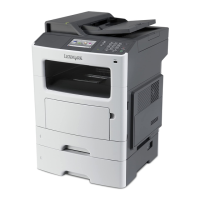Creating an e-mail shortcut using the Embedded
Web Server
1 Open a Web browser, and then type the printer IP address in the
address field.
Notes:
• View the printer IP address in the TCP/IP section in the
Network/Ports menu. The IP address appears as four sets of
numbers separated by periods, such as 123.123.123.123.
• If you are using a proxy server, then temporarily disable it to
load the Web page correctly.
2 Click Settings > Manage Shortcuts > E-mail Shortcut Setup.
3 Type a name for the shortcut, and then enter the e-mail address.
Note: If you are entering multiple addresses, then separate each
address with a comma (,).
4 Adjust the scan settings, if necessary.
5 Enter a shortcut number, and then click Add.
If you enter a number that is already in use, then you are prompted
to select another number.
Canceling an e-mail
From the printer control panel, press .
Faxing
Sending a fax
Sending a fax using the printer control panel
1 Load an original document faceup, short edge first into the ADF
tray or facedown on the scanner glass.
Notes:
• Do not load postcards, photos, small items, transparencies,
photo paper, or thin media (such as magazine clippings) into
the ADF tray. Place these items on the scanner glass.
• The ADF indicator light comes on when the paper is loaded
properly.
2 If you are loading a document into the ADF tray, then adjust the
paper guides.
3 From the printer control panel, navigate to:
> Fax > > enter a fax or shortcut number on the
keypad >
> Original Size >
Note: If you want to fax another document, then place it on the
scanner glass, press the left or right arrow button to scroll to
Scan the Next Page, and then press
.
4 Press the left or right arrow button to scroll to Finish the Job, and
then press
.
Sending a fax using the computer
For Windows users
1
With a document open, click File > Print.
2 Select the printer, and then click Properties, Preferences,
Options, or Setup.
3 Click Fax > Enable fax, and then enter the recipient fax number or
numbers.
4 If necessary, configure other fax settings.
5 Apply the changes, and then send the fax job.
Notes:
• The fax option is available only with the PostScript driver or the
Universal Fax Driver. For more information, contact the place
where you purchased the printer.
• To use the fax option with the PostScript driver, configure and
enable it in the Configuration tab.
For Macintosh users
1
With a document open, choose File > Print.
2 Select the printer.
3 Enter the recipient fax number, and then configure other fax
settings, if necessary.
4 Send the fax job.
Sending a fax using a shortcut number
Fax shortcuts are just like the speed dial numbers on a telephone or
fax machine. A shortcut number (1–999) can contain a single recipient
or multiple recipients.
1 Load an original document faceup, short edge first into the ADF
tray or facedown on the scanner glass.
Notes:
• Do not load postcards, photos, small items, transparencies,
photo paper, or thin media (such as magazine clippings) into
the ADF tray. Place these items on the scanner glass.
• The ADF indicator light comes on when the paper is loaded
properly.
2 If you are loading a document into the ADF tray, then adjust the
paper guides.
3 Press # , and then enter the shortcut number on the keypad.
4 Press .
Sending a fax at a scheduled time
1 Load an original document faceup, short edge first into the ADF
tray or facedown on the scanner glass.
Notes:
• Do not load postcards, photos, small items, transparencies,
photo paper, or thin media (such as magazine clippings) into
the ADF tray. Place these items on the scanner glass.
• The ADF indicator light comes on when the paper is loaded
properly into the ADF tray.
2 If you are loading a document into the ADF tray, then adjust the
paper guides.
3 From the printer control panel, navigate to:
> Fax > > enter the fax number > Delayed Send > Send
Later > select the date you want the fax to be sent >
> select
the time you want the fax to be sent >
4 Press .
Note: The document is scanned, and then faxed at the
scheduled time.
8

